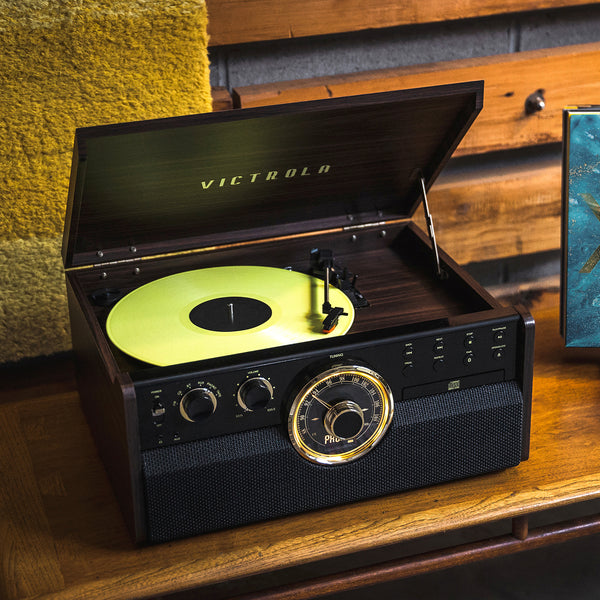A Guide to Vinyl Record Sizes

Origin of the Record Player
So you’ve got your record player set up in the listening space of your choice, ready to drop the needle on your favorite album. Once you do, a sense of puzzlement arises when you hear the music being played back twice as fast with high-pitched vocals coming at you. You quickly realize the problem and switch the player to 33 1/3 speed and all is well. It’s got you thinking though, what actually is the deal with different record sizes? Fortunately for you, Victrola’s got the answers.
To put it briefly, the record players of the late 19th century are almost nothing like the record players that fit comfortably in our homes today. In fact, they didn’t even play disks. Thomas Edison’s original phonograph would record sound waves onto a tinfoil cylinder and play them back through a horn. It wasn’t until several years later that Emil Berliner created what we now know as a record, a flat disk with grooves that are read by a needle and played back. Berliner’s innovations allowed records to be mass produced, bringing music on-demand inside the home for the first time.

How Does a Vinyl Record Work?
It’s a question pretty much everyone has wondered, so we’ve covered this in a previous blog post. To summarize, a vinyl record is made using a master copy, which is made by a stylus cutting grooves into a round disk, which is then used to create a disk that has grooves instead of ridges. This “negative” of a record is then pressed into softened vinyl, producing a vinyl record we can buy in a store.
To play the music back, the arm of a record player has a stylus that reads the grooves and generates an electrical signal that is carried out by an amplifier. The needle acts as a transducer, converting vibrations into an electrical signal we can hear. The needle reads the information stored on the record, sends it up the tonearm and converts it into electrical energy, finally sending it out to be amplified through speakers.

Record Sizes
Vinyl records can be produced in three different sizes. The ones you’re probably the most used to are 12-inch records, or long-plays (LPs for short.) Of course, different sizes also means different speeds. A larger record will spin around the platter fewer times per minute than a smaller record. An LP spins at 33 1/3 revolutions per minute, or RPM. Your record player will have a switch that determines the proper speed at which a record will play, and while it may be funny to hear your favorite songs played in fast-motion, it can end up damaging your vinyl.
The second most common record size is a 7-inch disk, which spins at 45 RPM. This size is generally used for singles, with just one or two songs per side. Relatively uncommon these days is the 10-inch record, spinning at 78 RPM. These were the standard in the early days of vinyl, but were largely fazed out by the 1950s. Advances in technology allowed for the production of larger records (LPs) that could store a lot more music. Where 10-inch records contained around five minutes of music per side, a 12-inch record could store 22. This changed the music industry as we know it, as artists began focusing on recording and releasing around 45 minutes of music as opposed to just 10. This led to greater emphasis on storytelling and the rise of album-focused recording and listening.
78 RPM records are largely out of production and are generally only found in vintage shops or inherited. If you’re not an avid collector or hobbyist, you probably won’t encounter them often. In fact, many modern record players only play records at 33 1/3 and 45 RPM due to the scarcity of 78s on the market. Fortunately, if you’re in possession of any, Victrola carries a large assortment of 3-speed record players.
Funnily enough, those 78s you dug out of your grandparents’ collection are probably the best sounding records in your home. The faster a record spins, the better sound quality it produces. As we covered above, the tradeoff lies in the short playback time. A 78 may sound great, but you’re only going to be listening for around 10 minutes, leading 78s to develop a reputation for untapped potential.
The weight of the record is also a factor. LPs generally weigh anywhere between 80 and 200 grams, with 180 grams considered something of a sweet spot by most listeners. The heavier a record, the less likely it will shift as it spins, leading to a more cohesive listening experience.

Caring for your Vinyl
Of course, no matter the size or weight, records will naturally start to degrade over time, so it’s important to care for them as best you can. To prevent warping, store your vinyl in a temperature-controlled area. The temperature in a room like an attic or garage tends to fluctuate, and can lead to your vinyl melting, making it unplayable. Victrola has a number of storage solutions that look awesome in the home, like our Wooden Record Crate or Vinyl Record Stand, so you can show off your collection.
If you notice your records have a buildup of dust or grime, you’re going to want to clean it. Victrola’s Vinyl Record Cleaning Kit makes it easy. The anti-static brush removes dust while the record spins, and if you want to give it a deep clean, just spray a small amount of cleaning solution onto the surface of the record and wipe it down with the microfiber cloth.
We hope this quick guide answered some of your questions! If you’re ready to dive back into the world of vinyl after learning something new, check out the Victrola Record Store to find some of your favorites.



















